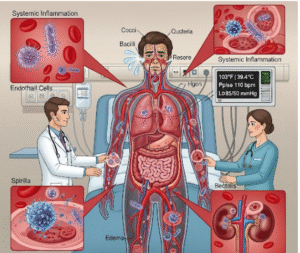Overview
Roth spots are retinal hemorrhages with pale or white centers visible during an eye examination. They are not a disease themselves but a clinical sign of underlying systemic conditions, often indicating serious or potentially life-threatening illnesses.
In Korea, ophthalmologists and internists identify Roth spots during routine fundoscopic examinations, particularly when patients present with systemic infections, blood disorders, or vascular abnormalities. Detecting Roth spots early can prompt timely investigation and treatment of underlying diseases.
➤ Visible as small, round, red spots with white centers on the retina
➤ Usually detected during an eye examination
➤ Indicate systemic issues such as infection or blood disorders
➤ Require urgent evaluation for underlying cause
Key Facts
➤ Roth spots are often associated with infective endocarditis, but can also occur in diabetes, leukemia, anemia, hypertension, or trauma.
➤ Can appear in one or both eyes
➤ May not affect vision directly, but underlying conditions can have serious consequences
➤ Timely diagnosis can prevent complications like heart failure or systemic emboli
What Are Roth Spots?
Roth spots are retinal hemorrhages with a pale center composed of fibrin, white blood cells, or bacterial aggregates. They result from vascular damage in the retina due to circulating immune complexes, bacterial infections, or hematologic abnormalities.
They are typically round or oval, small, and may be scattered throughout the retina.
What Symptoms Are Related To
Roth spots themselves often do not produce symptoms, but associated conditions may include:
➤ Blurred or decreased vision (if hemorrhages affect the macula)
➤ Fever, chills, or malaise (infective endocarditis)
➤ Petechiae, purpura, or other bleeding signs (hematologic disorders)
➤ Fatigue or pallor (anemia)
➤ Shortness of breath, palpitations (heart involvement)
➤ Headaches or neurologic symptoms (if emboli occur)
What Causes / Possible Causes
Roth spots are typically a marker of systemic disease, including:
Infections
➤ Infective endocarditis – classic association
➤ Bacterial sepsis or severe systemic infections
Hematologic & Vascular Disorders
➤ Leukemia or lymphoma
➤ Severe anemia or thrombocytopenia
➤ Hypertension or diabetic retinopathy
Other Causes
➤ Trauma or injury to the eye
➤ Autoimmune diseases (e.g., lupus, vasculitis)
➤ Pre-eclampsia or other systemic vascular disorders
When Should I See My Doctor
Immediate medical attention is required if Roth spots are suspected, especially if accompanied by:
➤ Fever, chills, or persistent fatigue
➤ Heart murmur, palpitations, or shortness of breath
➤ Bleeding from other sites (skin, gums, or nose)
➤ Sudden vision changes
➤ History of cardiac disease, diabetes, or blood disorders
⚠️ Roth spots can indicate potentially life-threatening conditions, so early evaluation is essential.
Care and Treatment
Since Roth spots are a sign rather than a disease, treatment focuses on addressing the underlying cause:
Medical Management
➤ Antibiotics for infective endocarditis or systemic infection
➤ Blood transfusions or chemotherapy for leukemia or severe anemia
➤ Control of blood pressure or diabetes to prevent vascular damage
➤ Immunosuppressive therapy for autoimmune causes
Ophthalmologic Care
➤ Regular fundoscopic exams to monitor retinal health
➤ Vision assessment if Roth spots involve the macula
➤ Laser or other interventions if complications like retinal detachment occur (rare)
Treatment Options in Korea
Korea offers advanced ophthalmology and systemic care for patients with Roth spots:
➤ Diagnostics
➤ Fundoscopy by ophthalmologists
➤ Optical coherence tomography (OCT) for detailed retinal imaging
➤ Blood tests (CBC, cultures) to identify infection or hematologic abnormalities
➤ Echocardiography to detect infective endocarditis or cardiac vegetations
➤ Treatment Approaches
➤ Targeted antibiotic therapy for bacterial infections
➤ Hematology consultation for leukemia, anemia, or thrombocytopenia
➤ Multidisciplinary management for autoimmune or systemic vascular disorders
➤ Follow-up retinal exams to monitor resolution of Roth spots
➤ Top Hospitals in Korea for Roth Spots & Underlying Conditions
➤ Seoul National University Hospital – Ophthalmology & Cardiology
➤ Asan Medical Center – Infectious disease and hematology specialists
➤ Samsung Medical Center – Advanced retinal imaging and systemic disease management
➤ Severance Hospital (Yonsei University) – Multidisciplinary systemic and ocular care
Final Thoughts
Roth spots are a key clinical indicator of serious systemic conditions. While they may not cause symptoms themselves, their presence can signal infections, hematologic disorders, or vascular disease.
In Korea, patients benefit from early detection through eye exams, advanced imaging, and multidisciplinary care, allowing prompt treatment of underlying causes and prevention of serious complications.
If you notice sudden vision changes, unexplained fever, or other systemic symptoms, consult a doctor immediately for comprehensive evaluation.













